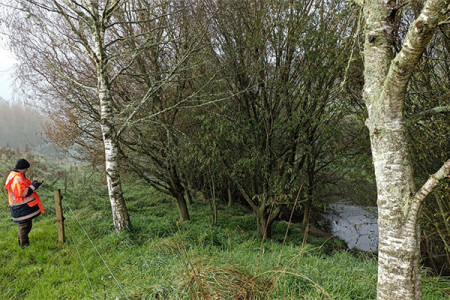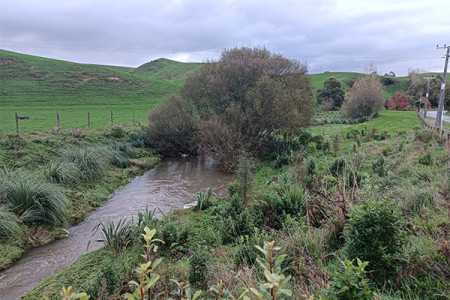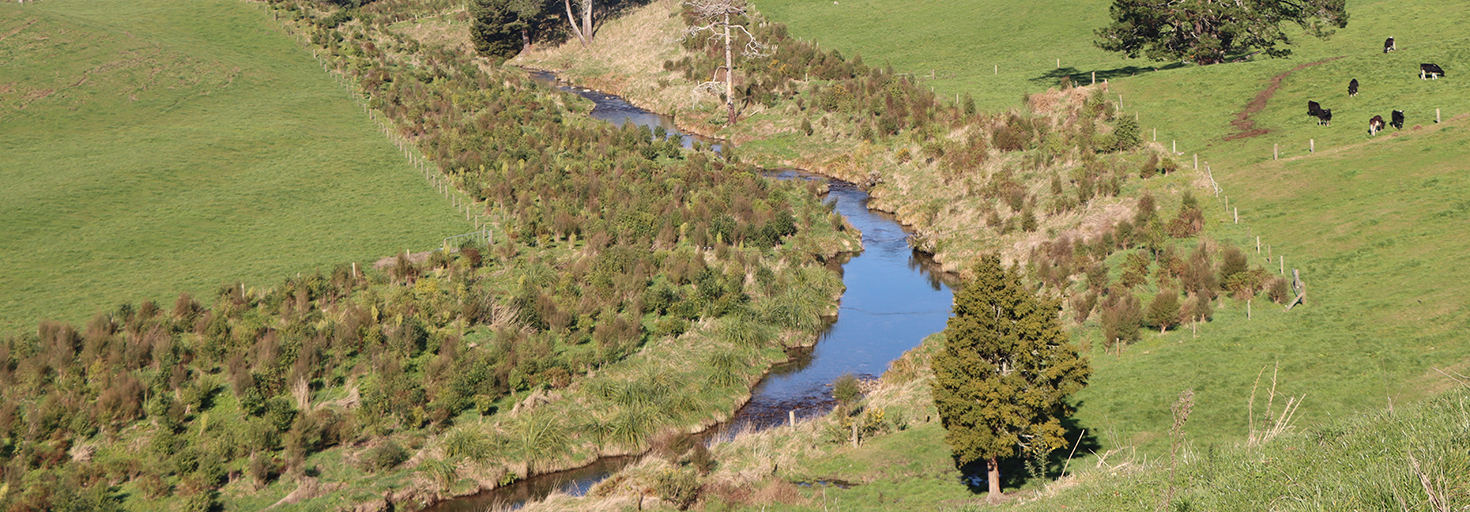In 2022, we monitored over 430 sites across the region. We would like to acknowledge the contribution of all participating landowners who allowed us to access the survey sites on their properties.

Riparian monitoring at the Tahunaatara Stream in the Upper Waikato Catchment.
A long-running WRC regional survey of riparian margins along waterways in pastoral land, spanning from 2002 to 2022, has demonstrated some important changes in some riparian characteristics, including improvements in fencing and stock exclusion, increases in native vegetation, and a decrease in stock access to waterways.
Riparian margins provide several important ecosystem functions, including:

Riparian planting at the Mangare Stream, Upper Waikato Catchment
- Water quality improvement – Riparian vegetation can filter pollutants such as excess nutrients, sediment, and pathogens before they reach the water, helping to improve water quality.
- Erosion control – Plant roots stabilise streambanks, reducing bank erosion and the input of sediment into waterways.
- Habitat support – Riparian margins provide a range of habitats for native species. These areas can serve as crucial habitat and breeding areas for native species, while the plants offer overhanging shelter and a food source for aquatic animals.
- Temperature regulation – Once established, riparian vegetation shades the water, helping to lower its temperature. This limits the growth of weeds and algae, while also maintaining stable conditions that support aquatic life.
- Flood attenuation – Riparian margins can temporarily store and slow the flow of water during floods, reducing flood impacts downstream.

Thanks to the landowners for working with us on this survey, we couldn’t do it without you.
In 2002, when the first region-wide riparian survey was undertaken, about 29 per cent of streambanks on pastoral land were effectively fenced to exclude livestock. By 2022, that figure had doubled to 58 per cent, with some catchment management zones such as Waihou-Piako and Upper Waikato reaching an average proportion of over 80 per cent of bank length effectively fenced. Increases in effective fencing have significantly reduced stock access to waterways across many parts of the region, helping to protect our waterways.
The survey, conducted every five years, evaluates fencing, vegetation type and coverage, buffer widths, stream crossings, and stream bank erosion at 430 randomly selected sites. Each site consists of a 500-meter stretch of waterway, assessed by WRC staff using a standardised riparian assessment methodology. This important undertaking would not be possible without the generous contribution of the landowners, says Waikato Regional Council Soil and Land Scientist Tim Norris.
“The survey provides valuable insight into the current state of our riparian margins across the region and helps us to track important changes in riparian attributes over time.”
Many challenges remain in our riparian areas, particularly on drystock farms and in steep hill-country where effective fencing remains both difficult and expensive to implement, and in many cases is not required by regulation. Excluding stock from the 42 per cent of stream banks that don’t have permanent fencing will require significant advocacy and support for landowners. Emerging technologies, such as virtual fencing, could greatly enhance the protection of riparian margins in the future, along with freshwater farm plans that may encourage further fencing.
The most recent survey revealed that non-woody vegetation such as grasses and weeds, dominated 73 per cent of the assessed stream bank length, while native woody species accounted for just 11 per cent. However, this represents a 6 per cent increase over the past two decades, indicating promising progress in riparian restoration efforts. The survey’s findings are more than just data points—they reflect the collective action of landowners, councils, industry, funders and communities working for the health of Waikato’s waterways. “The next survey will be important for measuring progress and building on the long-term riparian survey dataset,” Tim concludes.
As climate pressures mount and freshwater ecosystems face growing pressures, riparian restoration continues to be an important tool for improving freshwater outcomes.



